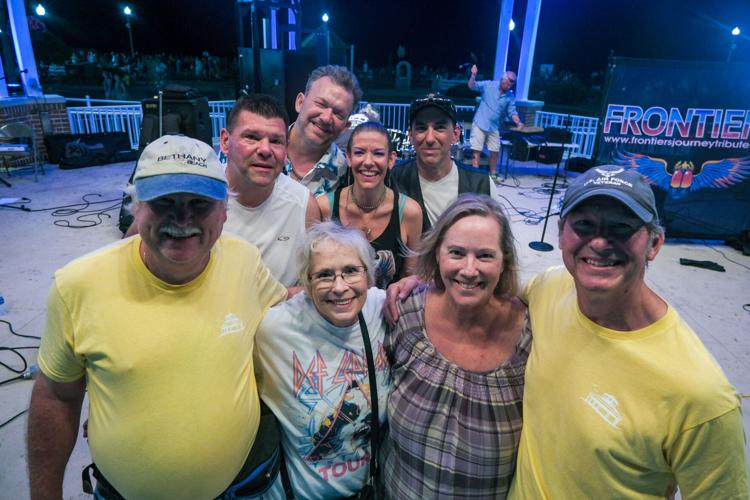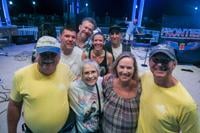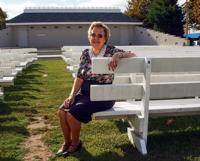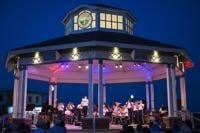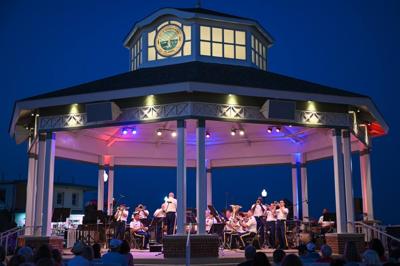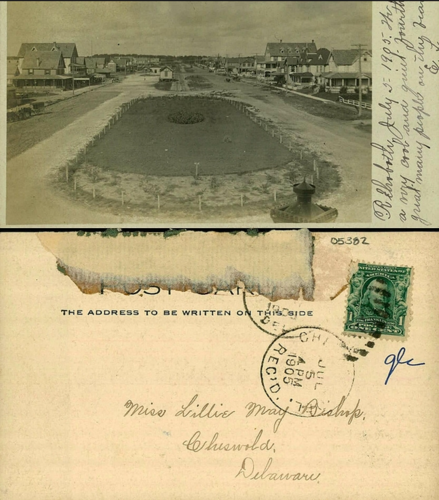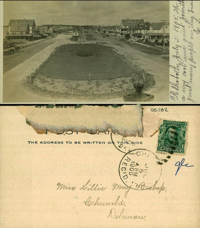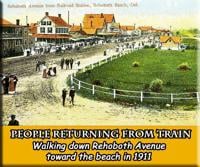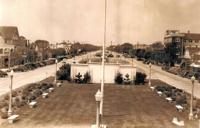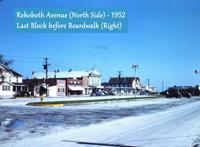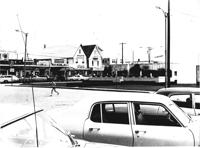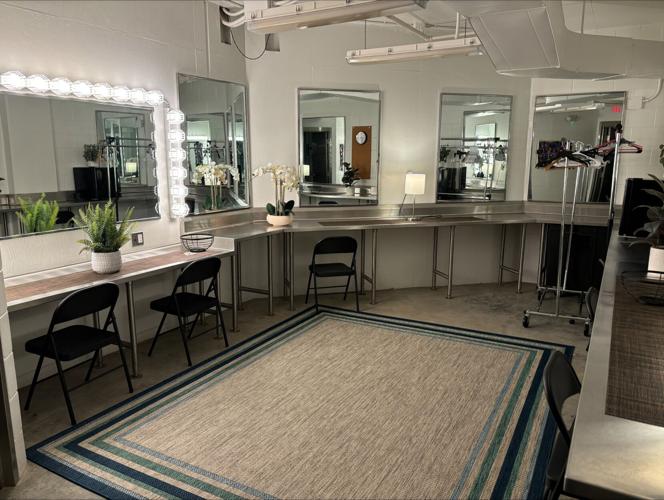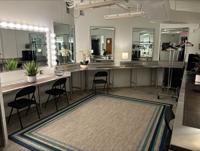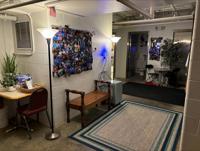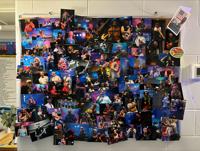REHOBOTH BEACH, Del. - Patti Murphy is a self-described live music junkie. She lives in Millville and explained her weekly concert schedule to me, which frequently takes her to multiple beach towns and includes performances at the Bethany Beach boardwalk, Evans Park, Northside Park, in Ocean Pines and at the Rehoboth Beach Bandstand, which is where we met.
At Rehoboth's June 22 concert featuring Journey tribute band The Frontiers, Murphy sat towards the front of the crowd while wearing a Def Leppard t-shirt.
"I've been into rock and roll since my mother bought me a transistor radio when I was little," she said smiling. "Here I am, old now, and I still love music."
The sound of live music on weekends in downtown Rehoboth is as representative of a summer at the beach as the smell of Thrasher's French Fries and dodging diving seagulls or waiting in line at The Ice Cream Store. Though the concerts are now a staple each summer, they, and the bandstand itself, are still a relatively new addition in the larger history of the Nation's Summer Capital.
REHOBOTH BANDSTAND HISTORY
There is surprisingly no official history of the Rehoboth Beach Bandstand, though anecdotes from Ruth Hayes, whose husband Bill conceptualized the space, and others have been collected.
According to the official bandstand website, Bill Hayes was permitted in 1963 by the City of Rehoboth Beach to invite local bands to perform on a grassy area where the current bandstand is now. Without a structure, it was simply referred to as "the green," and oral histories gathered by local historians corroborate this name. Folks like Lee Graham, who was born in Rehoboth in 1929, have shared stories of running and playing football in the space as a child.
Bill Hayes continued to schedule performances at the bandstand for three decades until his passing in 1994, at which time Ruth took over.

Ruth Hayes, whose husband, William, helped establish the Rehoboth concert series thousands continue to enjoy today. (Corey Groll/Rehoboth Beach Bandstand)
The early days of the bandstand go beyond that, however. Local historians have pieced together what I've come to learn is a real puzzle.
Paul Lovett lives downtown and could be described as an expert on the town's railroad era. He regularly gives lectures at the Rehoboth Beach Museum and is a major contributor to its realistic dioramas. He invited Donna Vassalotti, a childhood friend of his and fourth generation Rehoboth Beach resident, and me into his home to go through old photographs of downtown Rehoboth, many of which are from postcards dating back at least a century. Lovett and Vassalotti are able to determine the dates or years in which the photos were taken based on what buildings can be seen in them and compare them to other better-documented events like fires, business records and commissioner meeting notes.
Rehoboth Beach Bandstand: Through the years
The center median on Rehoboth Avenue was once dirt and grass, with cows and other animals present. Different iterations of a bandstand of sorts were constructed over 100 years, with today's bandstand being established in the early 2000s during a major streetscaping project.
A postcard postmarked in 1905 shows there was no building in the grassy oval in the center of Rehoboth Avenue at that time. Instead there was a large hole or basin, the purpose of which remains puzzling to local historians Paul Lovett and Donna Vassalotti. One guess has been a basin to hold water for livestock. (Donna Vassalotti)
Towards the end of the 1800s, railroad tracks and even cows stood where we're used to seeing rows of cars lining Rehoboth Avenue today. In fact, Lovett referred to a livestock problem that occurred on the avenue in 1891 during our interview. The first comfort station is estimated to have been built around 1907 and did not have plumbing but cleanouts, which needed to be emptied manually.
Then came the first bandstand, a gazebo-like structure that was brought into town in July of 1926. Just a year and a half later it was moved to Shaw Park, better known today as Grove Park, home of the playground and the Rehoboth Beach Farmer's Market.
A bid for the erection of a new bandstand and public restrooms was opened on May 12, 1928, at a commissioner meeting, according to meeting notes Lovett has gathered. The contract was awarded to John R. Tyndall for $1,200. Based on photos, the performance space was built by 1931. It featured a jagged shell-like back and side edges to frame performers with a white fence across the front, which was rounded out in the middle. Unlike today's iconic gazebo, this stage faced east, so the performers had an ocean view instead of the audience.
The stage portion seemed to have been removed or abandoned around the 1940s, though the wall remained, and reappeared at some point estimated to be near the 1970s, after Bill and Ruth Hayes got involved.
Fast forward to 2004, when the downtown area was undergoing a major streetscaping project that included moving utility wires underground and a great deal of paving sidewalks. This is when today's modern bandstand, an iconic octagonal gazebo through which audiences can enjoy watching the waves and musicians at the same time and that hosts concerts heard by up to 2,000 people each night, was built.
HOW BANDS ARE CHOSEN
A generation ago, the majority of performances were from jazz and military bands. To perform during Rehoboth Beach's summer concert series today, bands must fill out an application. The booking process begins in September for the following summer. A couple hundred groups apply each year along with crowd favorites that have been asked back. Each summer there are about 40 performance spots available, starting with Memorial Day weekend and then taking a pause until mid-June, when peak vacation season really begins. Groups submit information like audio and video samples.
"We have to be able to see something, to see where they've performed and what types of music they have. If it's more of a bar band, it's probably better off for something like a club. These are not performances you can hear at a restaurant, although those are great!" said program director Corey Groll. "The difference is that we've got a big stage to fill and we want to bring people in from the outside. When you're on the sidewalks and you hear the music that you want to listen to, we want people to come in towards the bandstand and really enjoy themselves in an outdoor, lively area."
Groups that make it to the bandstand stage are required to perform a straight set with no breaks, utilize the stage in an exciting and engaging manner and provide family-friendly acts. Groll aims to reach as many people as possible by including a variety of music genres. Knowing that many folks come for a week-long vacation, he considers how he can implement diversity throughout each weekend. That's why you'll rarely find a weekend with multiple tribute bands, or multiple jazz bands.
"There should always be some kind of music that you're looking for and you can come into town for," Groll said. "It's not just one great thing that we have every single weekend."
Bands that perform at the Rehoboth Beach Bandstand are paid, and part of their application includes listing an asking price. The concerts, however, are always free to attend, thanks to a portion of the city's budget dedicated to these events, and have been since they began in 1963. There are no plans to charge any time soon, according to Groll, and the bands seem to appreciate the crowds.
"This is our fourth year playing in Rehoboth. We love it here. We always have a great time, the streets fill up, the dressing rooms are comfortable," said The Frontiers lead singer Elaine Tuttle, who performed on June 22. "As far as the people who run it, we're very well taken care of. There are some places we wouldn't want to go back to, but we love staying here."
Underground dressing rooms
Performers are able to find a moment of peace and quiet before and after their shows in dressing rooms beneath Rehoboth Avenue.
MEET THE MUSIC MAN: PROGRAM DIRECTOR COREY GROLL

Corey Groll teaches most of the year but helps bring high-quality entertainment to tens of thousands of visitors each summer through his work at the Rehoboth Beach Bandstand. His involvement began in 1991 when he started as a sound technician. After the passing of Ruth Hayes, he took over the role of program director. (Rehoboth Beach Bandstand)
Corey Groll has been involved with the bandstand's performances since 1991. He began by running sound for about 14 years, first as a summer job while in high school and continuing in the following summers after he became a teacher. He thought it would be a great opportunity to try something different in comparison to his previous job at the Sunglass Hut.
He then went on to take over the programming of the bandstand when Ruth Hayes, who helped to establish the modern day concert series with her husband in the 1960s, passed away. In this role, Groll sets the schedule for the summer concerts and chooses which bands come to play.
"Rehoboth has always been something I've loved being a part of and I can't say there's anything wrong with standing in the middle of the avenue and looking straight down, watching the sunset," Groll said. "We're the only ones in town who are able to do something like this, so I think it's a great opportunity and I don't take it for granted for a second."
COMMUNITY CONNECTIONS
Groll isn't the only one who's become captivated by the local music scene.
John and Ginger Donahue are from Columbia, Md., and have a home in Rehoboth just six blocks away from Rehoboth Avenue. The couple went to a lot of concerts in the '70s and '80s and continue to love live music. They usually make it to five or six concerts at the Rehoboth Beach Bandstand each year and appreciate all it has to offer, though they look forward to certain groups like military and jazz bands.
"Some of the groups really draw us in. Others we've gone out of our way to see, like the Eagles tributes," John said. "We love the concerts, we love the venue and the sound quality is good."
"It's great to be around groups we like," Ginger added. "It's amazing they get this caliber of groups to play for free concerts."
Patti Murphy, our music junkie and expert on the local music scene, agrees wholeheartedly.
"I get to hear the music I've always loved live, not just playing it at home. It kind of sucks you in, the ambiance and the whole atmosphere. Everyone is enjoying the music," Murphy said. She leaned into her husband, Ron, and gestured to friends Carol and Blaine Whitten, who are from Clarksville. "It brings people together, strangers. They're nice when they talk to you. That's how we all met!"
In a world where being busy is a badge of honor and we struggle at times to slow down and connect with the world around us, something as simple as music floating on a summer breeze has kept its power for generations, creating a sense of community for locals and visitors alike. As Murphy put it, "You could be at home watching TV or you could be out here experiencing something."

Band members from The Frontiers and local concert attendees at a June 22 concert.
Third row, from left: Marc Windler, bass and backing vocals; Damon Marks, guitar. Second row, from left: Gerry Fortus, drums; Elaine Tuttle, voice. Front row, from left: Ron Murphy, Patti Murphy, Carol Whitten, Blaine Whitten.

